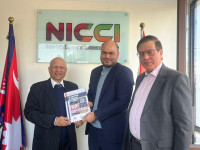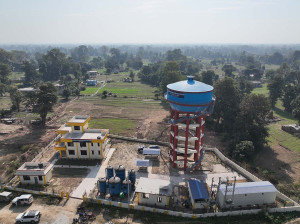Money
Electronic Know Your Customer to replace paperwork by November
Establishing a centralised biometric based e-KYC system will enable licensed service providers to serve their customers efficiently, officials say.
Krishana Prasain
Nepal’s telecom regulator is preparing to implement a centralised biometric based digital Know Your Customer, a process wherein an individual's identity and address are verified electronically through authentication of the National Identity.
The e-KYC will remove the paper form system now in use in the telecom, banking, transport licence and other sectors that require filling up KYCs.
This means that once an individual's details are entered in the e-KYC system, they will not be required to fill a KYC in other sectors including banks.
“From online transactions to information about health and wealth, individuals have been integrating their data through mobile phones. Thus the mobile phone needs to be well secured,” said Achyuta Nand Mishra, deputy director of the Nepal Telecommunications Authority.
“The system will help secure the individual’s personal data, and reduce the hassle of opening KYCs all the time. We have been receiving complaints about the misuse of SIM cards,” he said.
“The e-KYC is a biometric system that verifies the information of individuals. So, there is no duplication or cheating. Individuals need to fill up the form using their national ID number, and once the operator or the service provider makes a one-time entry in the e-KYC system, the user will be verified," Mishra said.
"Every new customer applying for a mobile SIM card needs to fill up the e-KYC form. Existing mobile customers will be given a certain period of time to fill up the e-KYC. The system is expected to come into implementation by November."
As of mid-January, there were 42.28 million voice telephone service subscribers in the country, which is 139.87 percent of the total population, according to the management and information system report of the authority. There are 824,924 fixed voice telephone users and 41.45 million mobile phone subscribers.
Currently, a person applying for a mobile SIM or subscribing to an internet connection or telephone line needs to fill up a customer application form and provide physical copies of proof of identity, proof of address and photographs.
With paper registration, there is a high chance of multiple subscriptions or fraudulent subscriptions of the services, the authority said.
Using non-registered or improperly registered SIM cards, avoidable security breaches such as terrorist acts and violent crimes have been committed in the world.
“Financial crimes have also been committed in the form of mobile-money fraud or illegal SIM swap, which has resulted in significant loss to the victims,” the authority said.
With the rapid increase in digital identity verification as a direct result of digital transformation initiatives, especially after the Covid-19 pandemic, account opening is moving online, and service providers demand a secure and safe method to verify identity and a digital KYC.
Establishing a centralised biometric based e-KYC system will enable licensed service providers to serve their customers efficiently and securely without compromising security, the authority said.
The system will serve as the master data repository which will be used for verification when performing a SIM swap, change of ownership and other services that the authority deems fit.
The e-KYC system for SIM registration and verification will be a centralised secured solution to support the authority to receive real-time or file-based subscriber KYC data from all telecommunications operators in Nepal.
The data of subscribers which are authenticated through the National Identity system and consist of biometric and demographic data of individuals and companies will be securely stored, as per the authority.
According to the authority, the system will have an interface to allow all licensed telecommunications operators to register details of new SIM card subscribers, re-registration of existing SIM card subscribers, mobile number porting of SIM card subscribers and SIM replacement of SIM card subscribers.
Performing a change of ownership, making additional SIM registration, retrieving registered information of SIM card subscribers and terminating the registered information record of SIM card subscribers will also be done, the authority said.
A system will be enabled for secure communication between licensees and the authority by which licensees can share and transfer a subscriber's information to the Nepal Telecommunications Authority.




 11.12°C Kathmandu
11.12°C Kathmandu













